Hospitality Operations: Food Production Systems, Service & Menu Plan
VerifiedAdded on 2023/06/15
|11
|3447
|144
Report
AI Summary
This report provides an analysis of hospitality operations, focusing on food production systems, food and beverage service methods, and menu planning considerations within the context of Holiday Inn. It examines various food production systems such as ready-prepared, conventional, and assembly-serve, highlighting their advantages and disadvantages. Different food and beverage service methods, including table service, English service, French service, cart service, buffet service, and room service, are also discussed. The report further explores critical considerations and constraints in menu planning, such as competition, customer profile, operational hours, and potential challenges like food allergies and outdoor catering. Finally, it touches upon the importance of sustainable menu planning to maintain competitiveness in the market, offering a comprehensive overview for a management trainee in the hospitality sector. Desklib provides access to this and other solved assignments for students.
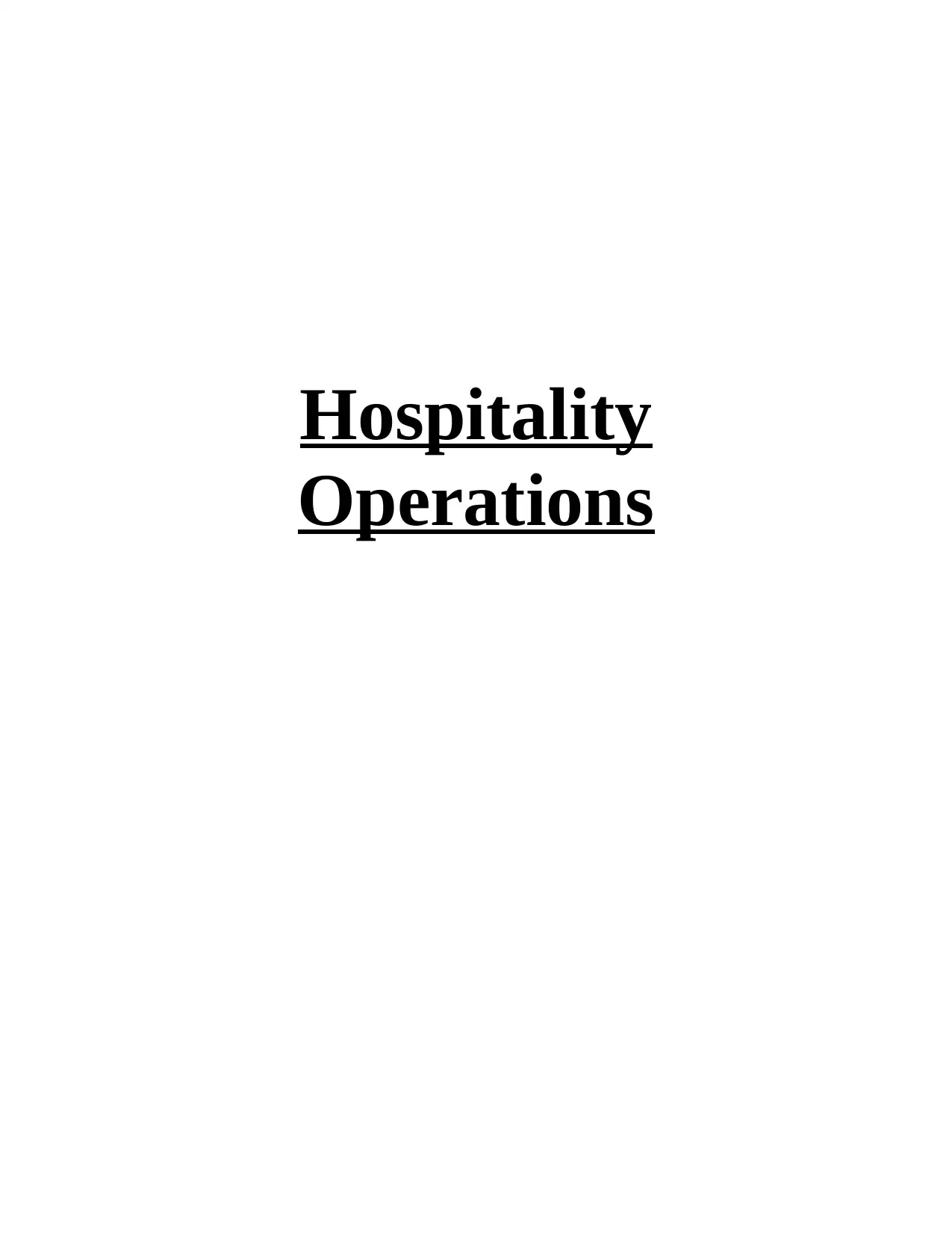
Hospitality
Operations
Operations
Paraphrase This Document
Need a fresh take? Get an instant paraphrase of this document with our AI Paraphraser
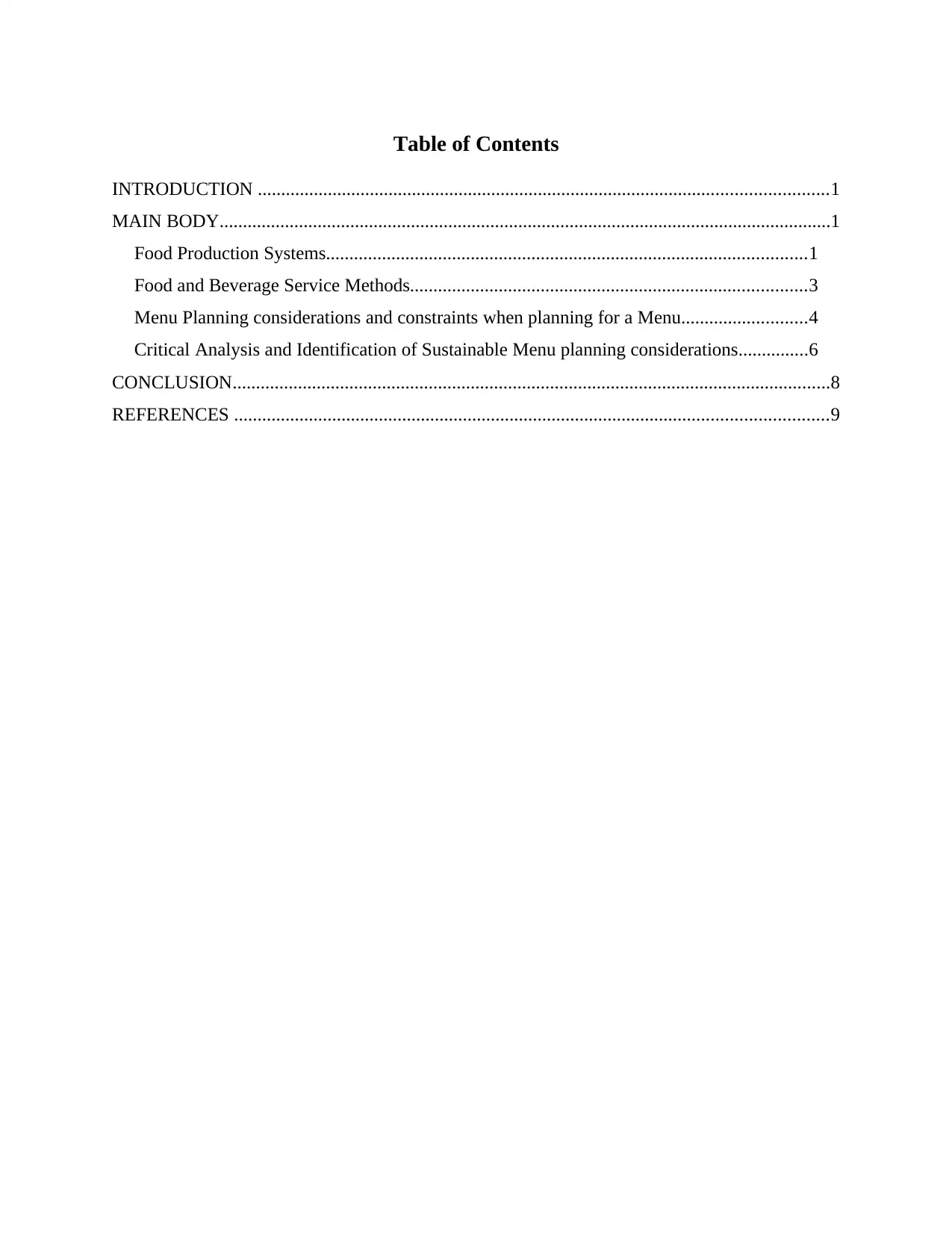
Table of Contents
INTRODUCTION ..........................................................................................................................1
MAIN BODY...................................................................................................................................1
Food Production Systems.......................................................................................................1
Food and Beverage Service Methods.....................................................................................3
Menu Planning considerations and constraints when planning for a Menu...........................4
Critical Analysis and Identification of Sustainable Menu planning considerations...............6
CONCLUSION................................................................................................................................8
REFERENCES ...............................................................................................................................9
INTRODUCTION ..........................................................................................................................1
MAIN BODY...................................................................................................................................1
Food Production Systems.......................................................................................................1
Food and Beverage Service Methods.....................................................................................3
Menu Planning considerations and constraints when planning for a Menu...........................4
Critical Analysis and Identification of Sustainable Menu planning considerations...............6
CONCLUSION................................................................................................................................8
REFERENCES ...............................................................................................................................9
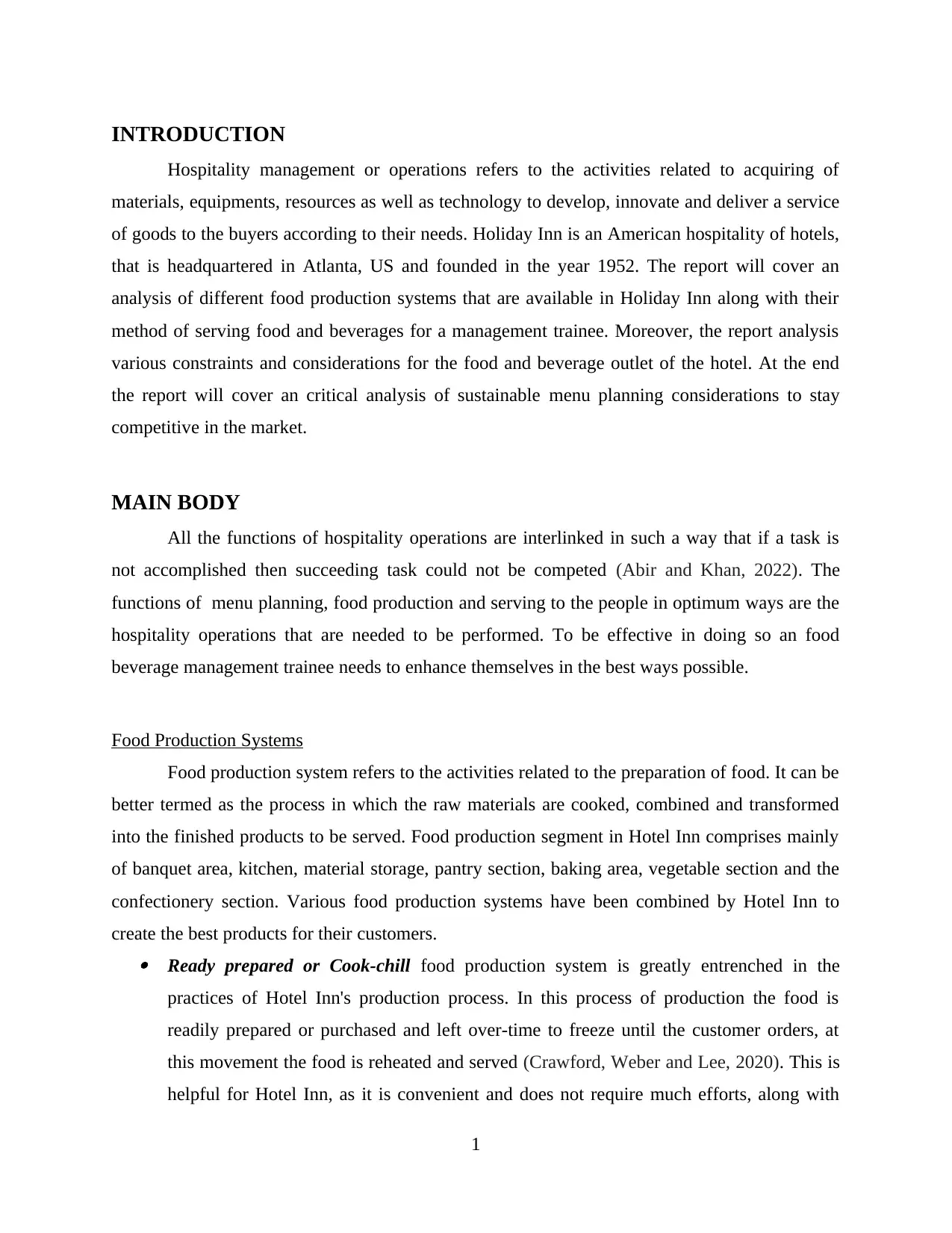
INTRODUCTION
Hospitality management or operations refers to the activities related to acquiring of
materials, equipments, resources as well as technology to develop, innovate and deliver a service
of goods to the buyers according to their needs. Holiday Inn is an American hospitality of hotels,
that is headquartered in Atlanta, US and founded in the year 1952. The report will cover an
analysis of different food production systems that are available in Holiday Inn along with their
method of serving food and beverages for a management trainee. Moreover, the report analysis
various constraints and considerations for the food and beverage outlet of the hotel. At the end
the report will cover an critical analysis of sustainable menu planning considerations to stay
competitive in the market.
MAIN BODY
All the functions of hospitality operations are interlinked in such a way that if a task is
not accomplished then succeeding task could not be competed (Abir and Khan, 2022). The
functions of menu planning, food production and serving to the people in optimum ways are the
hospitality operations that are needed to be performed. To be effective in doing so an food
beverage management trainee needs to enhance themselves in the best ways possible.
Food Production Systems
Food production system refers to the activities related to the preparation of food. It can be
better termed as the process in which the raw materials are cooked, combined and transformed
into the finished products to be served. Food production segment in Hotel Inn comprises mainly
of banquet area, kitchen, material storage, pantry section, baking area, vegetable section and the
confectionery section. Various food production systems have been combined by Hotel Inn to
create the best products for their customers. Ready prepared or Cook-chill food production system is greatly entrenched in the
practices of Hotel Inn's production process. In this process of production the food is
readily prepared or purchased and left over-time to freeze until the customer orders, at
this movement the food is reheated and served (Crawford, Weber and Lee, 2020). This is
helpful for Hotel Inn, as it is convenient and does not require much efforts, along with
1
Hospitality management or operations refers to the activities related to acquiring of
materials, equipments, resources as well as technology to develop, innovate and deliver a service
of goods to the buyers according to their needs. Holiday Inn is an American hospitality of hotels,
that is headquartered in Atlanta, US and founded in the year 1952. The report will cover an
analysis of different food production systems that are available in Holiday Inn along with their
method of serving food and beverages for a management trainee. Moreover, the report analysis
various constraints and considerations for the food and beverage outlet of the hotel. At the end
the report will cover an critical analysis of sustainable menu planning considerations to stay
competitive in the market.
MAIN BODY
All the functions of hospitality operations are interlinked in such a way that if a task is
not accomplished then succeeding task could not be competed (Abir and Khan, 2022). The
functions of menu planning, food production and serving to the people in optimum ways are the
hospitality operations that are needed to be performed. To be effective in doing so an food
beverage management trainee needs to enhance themselves in the best ways possible.
Food Production Systems
Food production system refers to the activities related to the preparation of food. It can be
better termed as the process in which the raw materials are cooked, combined and transformed
into the finished products to be served. Food production segment in Hotel Inn comprises mainly
of banquet area, kitchen, material storage, pantry section, baking area, vegetable section and the
confectionery section. Various food production systems have been combined by Hotel Inn to
create the best products for their customers. Ready prepared or Cook-chill food production system is greatly entrenched in the
practices of Hotel Inn's production process. In this process of production the food is
readily prepared or purchased and left over-time to freeze until the customer orders, at
this movement the food is reheated and served (Crawford, Weber and Lee, 2020). This is
helpful for Hotel Inn, as it is convenient and does not require much efforts, along with
1
⊘ This is a preview!⊘
Do you want full access?
Subscribe today to unlock all pages.

Trusted by 1+ million students worldwide
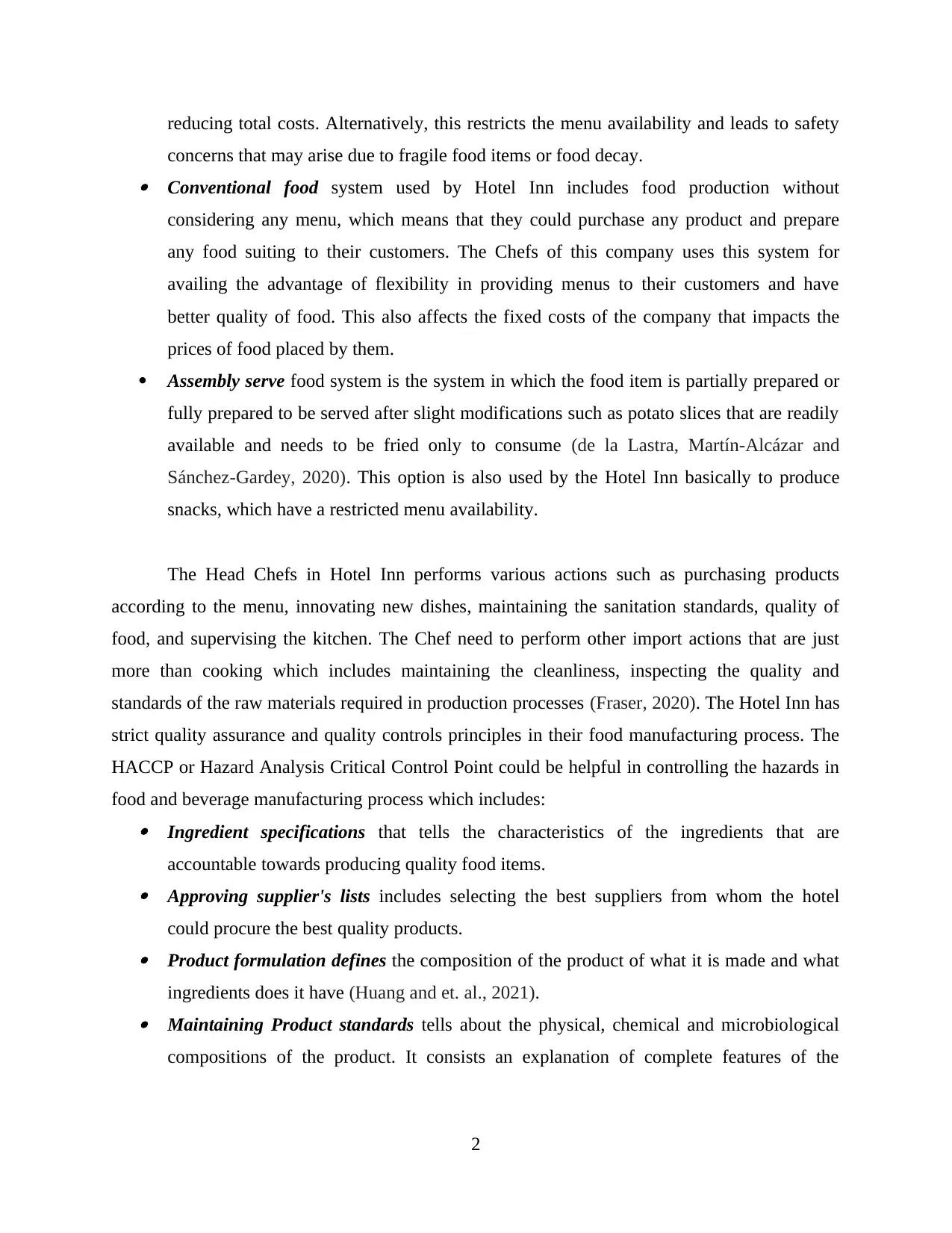
reducing total costs. Alternatively, this restricts the menu availability and leads to safety
concerns that may arise due to fragile food items or food decay. Conventional food system used by Hotel Inn includes food production without
considering any menu, which means that they could purchase any product and prepare
any food suiting to their customers. The Chefs of this company uses this system for
availing the advantage of flexibility in providing menus to their customers and have
better quality of food. This also affects the fixed costs of the company that impacts the
prices of food placed by them.
Assembly serve food system is the system in which the food item is partially prepared or
fully prepared to be served after slight modifications such as potato slices that are readily
available and needs to be fried only to consume (de la Lastra, Martín-Alcázar and
Sánchez-Gardey, 2020). This option is also used by the Hotel Inn basically to produce
snacks, which have a restricted menu availability.
The Head Chefs in Hotel Inn performs various actions such as purchasing products
according to the menu, innovating new dishes, maintaining the sanitation standards, quality of
food, and supervising the kitchen. The Chef need to perform other import actions that are just
more than cooking which includes maintaining the cleanliness, inspecting the quality and
standards of the raw materials required in production processes (Fraser, 2020). The Hotel Inn has
strict quality assurance and quality controls principles in their food manufacturing process. The
HACCP or Hazard Analysis Critical Control Point could be helpful in controlling the hazards in
food and beverage manufacturing process which includes: Ingredient specifications that tells the characteristics of the ingredients that are
accountable towards producing quality food items. Approving supplier's lists includes selecting the best suppliers from whom the hotel
could procure the best quality products. Product formulation defines the composition of the product of what it is made and what
ingredients does it have (Huang and et. al., 2021). Maintaining Product standards tells about the physical, chemical and microbiological
compositions of the product. It consists an explanation of complete features of the
2
concerns that may arise due to fragile food items or food decay. Conventional food system used by Hotel Inn includes food production without
considering any menu, which means that they could purchase any product and prepare
any food suiting to their customers. The Chefs of this company uses this system for
availing the advantage of flexibility in providing menus to their customers and have
better quality of food. This also affects the fixed costs of the company that impacts the
prices of food placed by them.
Assembly serve food system is the system in which the food item is partially prepared or
fully prepared to be served after slight modifications such as potato slices that are readily
available and needs to be fried only to consume (de la Lastra, Martín-Alcázar and
Sánchez-Gardey, 2020). This option is also used by the Hotel Inn basically to produce
snacks, which have a restricted menu availability.
The Head Chefs in Hotel Inn performs various actions such as purchasing products
according to the menu, innovating new dishes, maintaining the sanitation standards, quality of
food, and supervising the kitchen. The Chef need to perform other import actions that are just
more than cooking which includes maintaining the cleanliness, inspecting the quality and
standards of the raw materials required in production processes (Fraser, 2020). The Hotel Inn has
strict quality assurance and quality controls principles in their food manufacturing process. The
HACCP or Hazard Analysis Critical Control Point could be helpful in controlling the hazards in
food and beverage manufacturing process which includes: Ingredient specifications that tells the characteristics of the ingredients that are
accountable towards producing quality food items. Approving supplier's lists includes selecting the best suppliers from whom the hotel
could procure the best quality products. Product formulation defines the composition of the product of what it is made and what
ingredients does it have (Huang and et. al., 2021). Maintaining Product standards tells about the physical, chemical and microbiological
compositions of the product. It consists an explanation of complete features of the
2
Paraphrase This Document
Need a fresh take? Get an instant paraphrase of this document with our AI Paraphraser
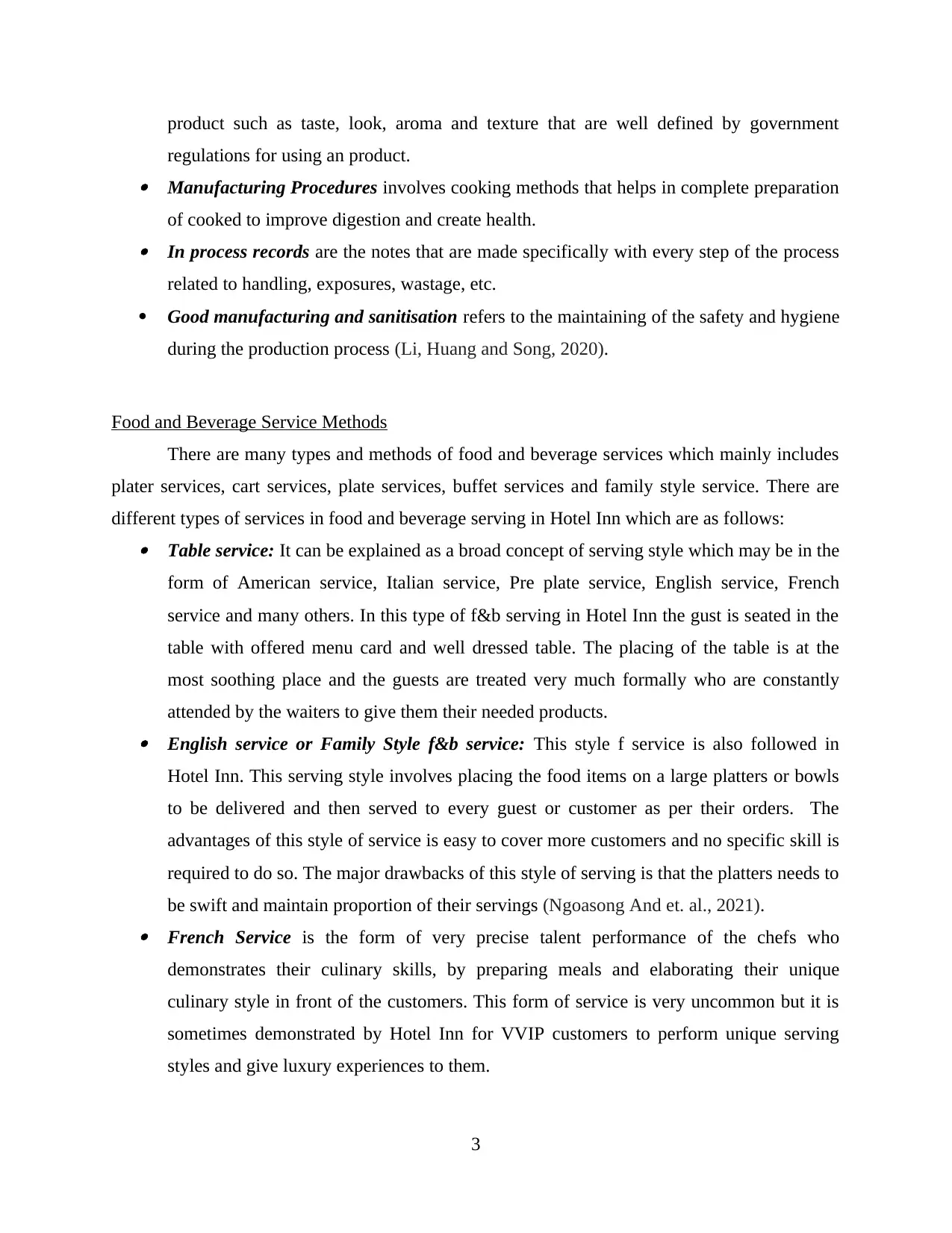
product such as taste, look, aroma and texture that are well defined by government
regulations for using an product. Manufacturing Procedures involves cooking methods that helps in complete preparation
of cooked to improve digestion and create health. In process records are the notes that are made specifically with every step of the process
related to handling, exposures, wastage, etc.
Good manufacturing and sanitisation refers to the maintaining of the safety and hygiene
during the production process (Li, Huang and Song, 2020).
Food and Beverage Service Methods
There are many types and methods of food and beverage services which mainly includes
plater services, cart services, plate services, buffet services and family style service. There are
different types of services in food and beverage serving in Hotel Inn which are as follows: Table service: It can be explained as a broad concept of serving style which may be in the
form of American service, Italian service, Pre plate service, English service, French
service and many others. In this type of f&b serving in Hotel Inn the gust is seated in the
table with offered menu card and well dressed table. The placing of the table is at the
most soothing place and the guests are treated very much formally who are constantly
attended by the waiters to give them their needed products. English service or Family Style f&b service: This style f service is also followed in
Hotel Inn. This serving style involves placing the food items on a large platters or bowls
to be delivered and then served to every guest or customer as per their orders. The
advantages of this style of service is easy to cover more customers and no specific skill is
required to do so. The major drawbacks of this style of serving is that the platters needs to
be swift and maintain proportion of their servings (Ngoasong And et. al., 2021). French Service is the form of very precise talent performance of the chefs who
demonstrates their culinary skills, by preparing meals and elaborating their unique
culinary style in front of the customers. This form of service is very uncommon but it is
sometimes demonstrated by Hotel Inn for VVIP customers to perform unique serving
styles and give luxury experiences to them.
3
regulations for using an product. Manufacturing Procedures involves cooking methods that helps in complete preparation
of cooked to improve digestion and create health. In process records are the notes that are made specifically with every step of the process
related to handling, exposures, wastage, etc.
Good manufacturing and sanitisation refers to the maintaining of the safety and hygiene
during the production process (Li, Huang and Song, 2020).
Food and Beverage Service Methods
There are many types and methods of food and beverage services which mainly includes
plater services, cart services, plate services, buffet services and family style service. There are
different types of services in food and beverage serving in Hotel Inn which are as follows: Table service: It can be explained as a broad concept of serving style which may be in the
form of American service, Italian service, Pre plate service, English service, French
service and many others. In this type of f&b serving in Hotel Inn the gust is seated in the
table with offered menu card and well dressed table. The placing of the table is at the
most soothing place and the guests are treated very much formally who are constantly
attended by the waiters to give them their needed products. English service or Family Style f&b service: This style f service is also followed in
Hotel Inn. This serving style involves placing the food items on a large platters or bowls
to be delivered and then served to every guest or customer as per their orders. The
advantages of this style of service is easy to cover more customers and no specific skill is
required to do so. The major drawbacks of this style of serving is that the platters needs to
be swift and maintain proportion of their servings (Ngoasong And et. al., 2021). French Service is the form of very precise talent performance of the chefs who
demonstrates their culinary skills, by preparing meals and elaborating their unique
culinary style in front of the customers. This form of service is very uncommon but it is
sometimes demonstrated by Hotel Inn for VVIP customers to perform unique serving
styles and give luxury experiences to them.
3
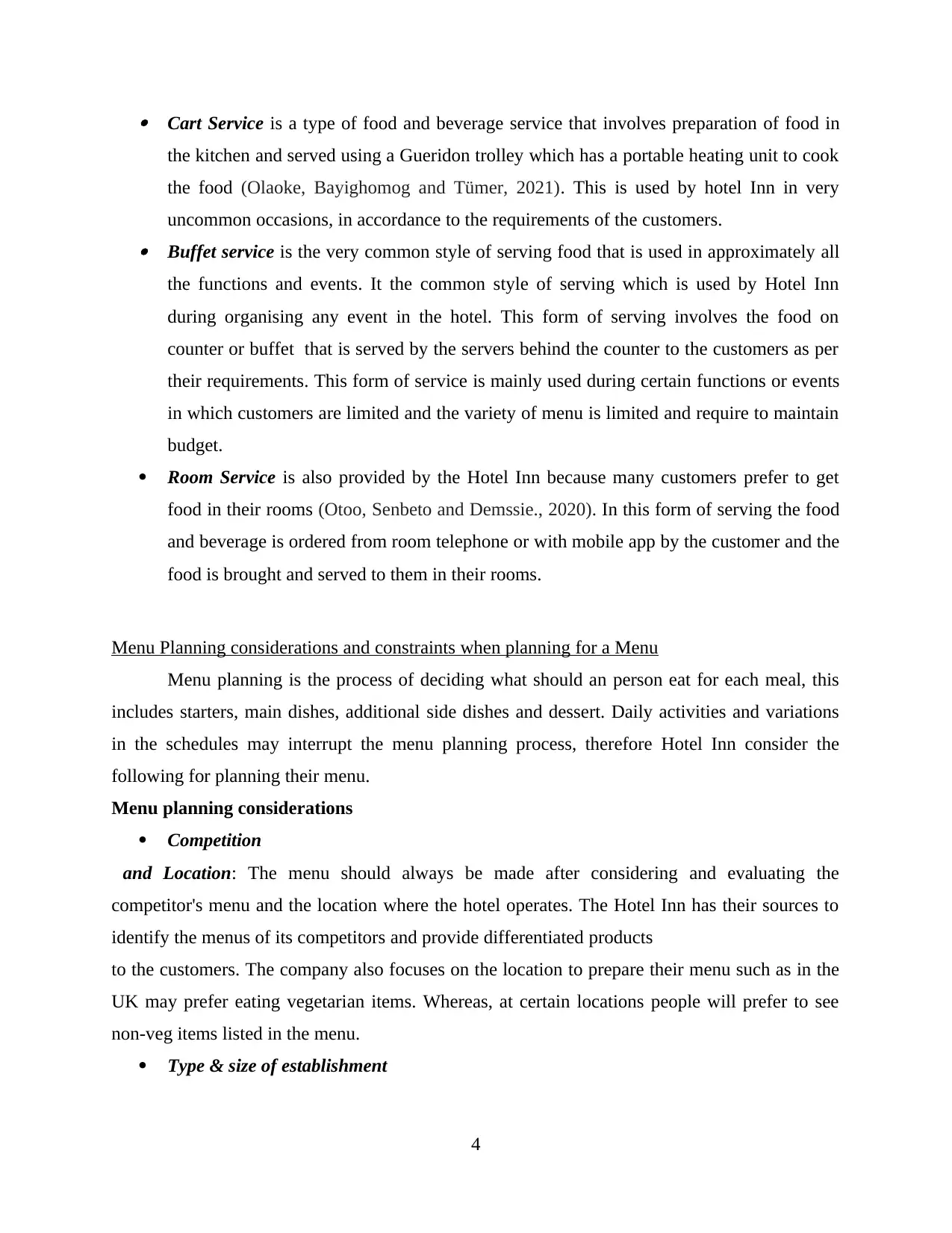
Cart Service is a type of food and beverage service that involves preparation of food in
the kitchen and served using a Gueridon trolley which has a portable heating unit to cook
the food (Olaoke, Bayighomog and Tümer, 2021). This is used by hotel Inn in very
uncommon occasions, in accordance to the requirements of the customers. Buffet service is the very common style of serving food that is used in approximately all
the functions and events. It the common style of serving which is used by Hotel Inn
during organising any event in the hotel. This form of serving involves the food on
counter or buffet that is served by the servers behind the counter to the customers as per
their requirements. This form of service is mainly used during certain functions or events
in which customers are limited and the variety of menu is limited and require to maintain
budget.
Room Service is also provided by the Hotel Inn because many customers prefer to get
food in their rooms (Otoo, Senbeto and Demssie., 2020). In this form of serving the food
and beverage is ordered from room telephone or with mobile app by the customer and the
food is brought and served to them in their rooms.
Menu Planning considerations and constraints when planning for a Menu
Menu planning is the process of deciding what should an person eat for each meal, this
includes starters, main dishes, additional side dishes and dessert. Daily activities and variations
in the schedules may interrupt the menu planning process, therefore Hotel Inn consider the
following for planning their menu.
Menu planning considerations
Competition
and Location: The menu should always be made after considering and evaluating the
competitor's menu and the location where the hotel operates. The Hotel Inn has their sources to
identify the menus of its competitors and provide differentiated products
to the customers. The company also focuses on the location to prepare their menu such as in the
UK may prefer eating vegetarian items. Whereas, at certain locations people will prefer to see
non-veg items listed in the menu.
Type & size of establishment
4
the kitchen and served using a Gueridon trolley which has a portable heating unit to cook
the food (Olaoke, Bayighomog and Tümer, 2021). This is used by hotel Inn in very
uncommon occasions, in accordance to the requirements of the customers. Buffet service is the very common style of serving food that is used in approximately all
the functions and events. It the common style of serving which is used by Hotel Inn
during organising any event in the hotel. This form of serving involves the food on
counter or buffet that is served by the servers behind the counter to the customers as per
their requirements. This form of service is mainly used during certain functions or events
in which customers are limited and the variety of menu is limited and require to maintain
budget.
Room Service is also provided by the Hotel Inn because many customers prefer to get
food in their rooms (Otoo, Senbeto and Demssie., 2020). In this form of serving the food
and beverage is ordered from room telephone or with mobile app by the customer and the
food is brought and served to them in their rooms.
Menu Planning considerations and constraints when planning for a Menu
Menu planning is the process of deciding what should an person eat for each meal, this
includes starters, main dishes, additional side dishes and dessert. Daily activities and variations
in the schedules may interrupt the menu planning process, therefore Hotel Inn consider the
following for planning their menu.
Menu planning considerations
Competition
and Location: The menu should always be made after considering and evaluating the
competitor's menu and the location where the hotel operates. The Hotel Inn has their sources to
identify the menus of its competitors and provide differentiated products
to the customers. The company also focuses on the location to prepare their menu such as in the
UK may prefer eating vegetarian items. Whereas, at certain locations people will prefer to see
non-veg items listed in the menu.
Type & size of establishment
4
⊘ This is a preview!⊘
Do you want full access?
Subscribe today to unlock all pages.

Trusted by 1+ million students worldwide
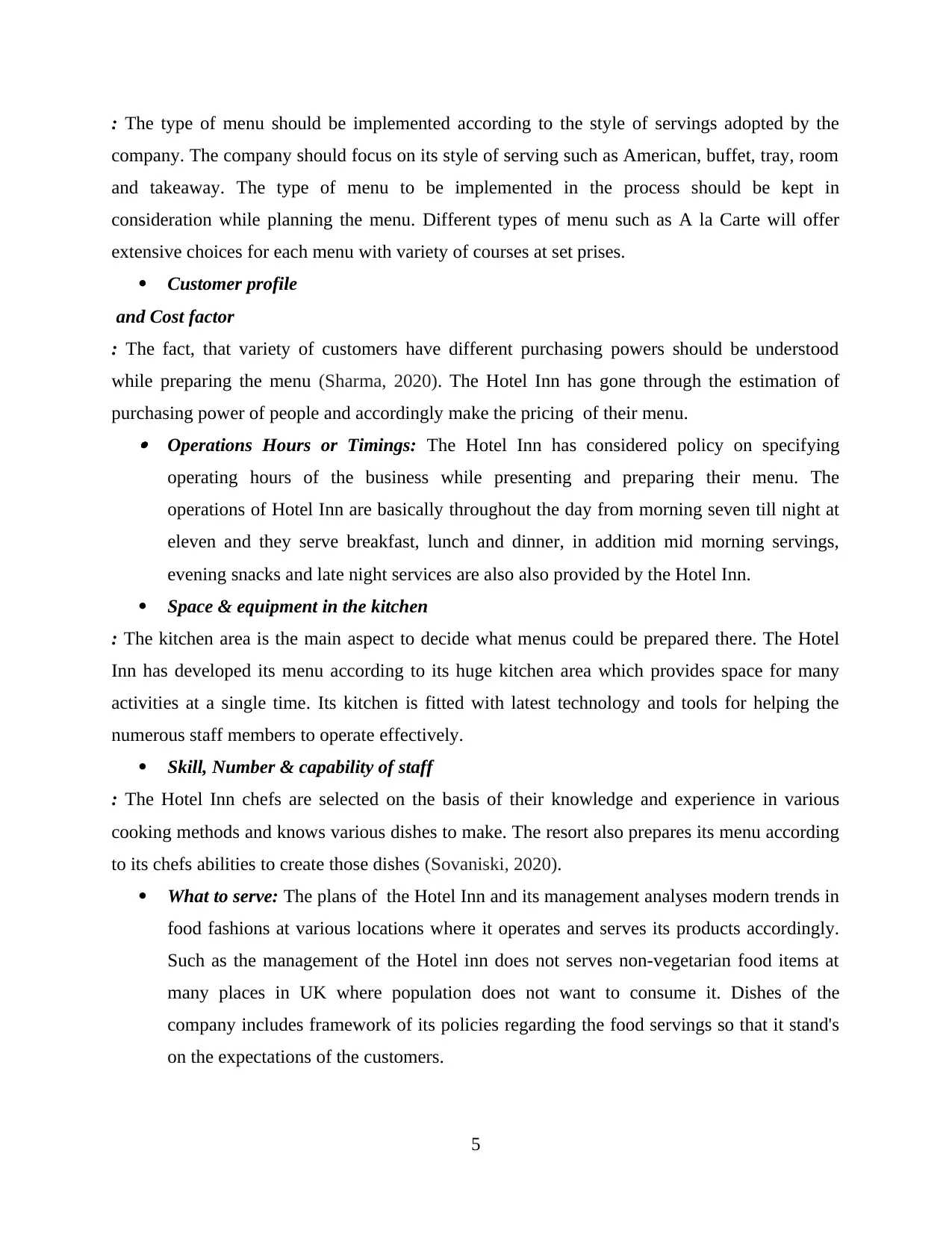
: The type of menu should be implemented according to the style of servings adopted by the
company. The company should focus on its style of serving such as American, buffet, tray, room
and takeaway. The type of menu to be implemented in the process should be kept in
consideration while planning the menu. Different types of menu such as A la Carte will offer
extensive choices for each menu with variety of courses at set prises.
Customer profile
and Cost factor
: The fact, that variety of customers have different purchasing powers should be understood
while preparing the menu (Sharma, 2020). The Hotel Inn has gone through the estimation of
purchasing power of people and accordingly make the pricing of their menu. Operations Hours or Timings: The Hotel Inn has considered policy on specifying
operating hours of the business while presenting and preparing their menu. The
operations of Hotel Inn are basically throughout the day from morning seven till night at
eleven and they serve breakfast, lunch and dinner, in addition mid morning servings,
evening snacks and late night services are also also provided by the Hotel Inn.
Space & equipment in the kitchen
: The kitchen area is the main aspect to decide what menus could be prepared there. The Hotel
Inn has developed its menu according to its huge kitchen area which provides space for many
activities at a single time. Its kitchen is fitted with latest technology and tools for helping the
numerous staff members to operate effectively.
Skill, Number & capability of staff
: The Hotel Inn chefs are selected on the basis of their knowledge and experience in various
cooking methods and knows various dishes to make. The resort also prepares its menu according
to its chefs abilities to create those dishes (Sovaniski, 2020).
What to serve: The plans of the Hotel Inn and its management analyses modern trends in
food fashions at various locations where it operates and serves its products accordingly.
Such as the management of the Hotel inn does not serves non-vegetarian food items at
many places in UK where population does not want to consume it. Dishes of the
company includes framework of its policies regarding the food servings so that it stand's
on the expectations of the customers.
5
company. The company should focus on its style of serving such as American, buffet, tray, room
and takeaway. The type of menu to be implemented in the process should be kept in
consideration while planning the menu. Different types of menu such as A la Carte will offer
extensive choices for each menu with variety of courses at set prises.
Customer profile
and Cost factor
: The fact, that variety of customers have different purchasing powers should be understood
while preparing the menu (Sharma, 2020). The Hotel Inn has gone through the estimation of
purchasing power of people and accordingly make the pricing of their menu. Operations Hours or Timings: The Hotel Inn has considered policy on specifying
operating hours of the business while presenting and preparing their menu. The
operations of Hotel Inn are basically throughout the day from morning seven till night at
eleven and they serve breakfast, lunch and dinner, in addition mid morning servings,
evening snacks and late night services are also also provided by the Hotel Inn.
Space & equipment in the kitchen
: The kitchen area is the main aspect to decide what menus could be prepared there. The Hotel
Inn has developed its menu according to its huge kitchen area which provides space for many
activities at a single time. Its kitchen is fitted with latest technology and tools for helping the
numerous staff members to operate effectively.
Skill, Number & capability of staff
: The Hotel Inn chefs are selected on the basis of their knowledge and experience in various
cooking methods and knows various dishes to make. The resort also prepares its menu according
to its chefs abilities to create those dishes (Sovaniski, 2020).
What to serve: The plans of the Hotel Inn and its management analyses modern trends in
food fashions at various locations where it operates and serves its products accordingly.
Such as the management of the Hotel inn does not serves non-vegetarian food items at
many places in UK where population does not want to consume it. Dishes of the
company includes framework of its policies regarding the food servings so that it stand's
on the expectations of the customers.
5
Paraphrase This Document
Need a fresh take? Get an instant paraphrase of this document with our AI Paraphraser
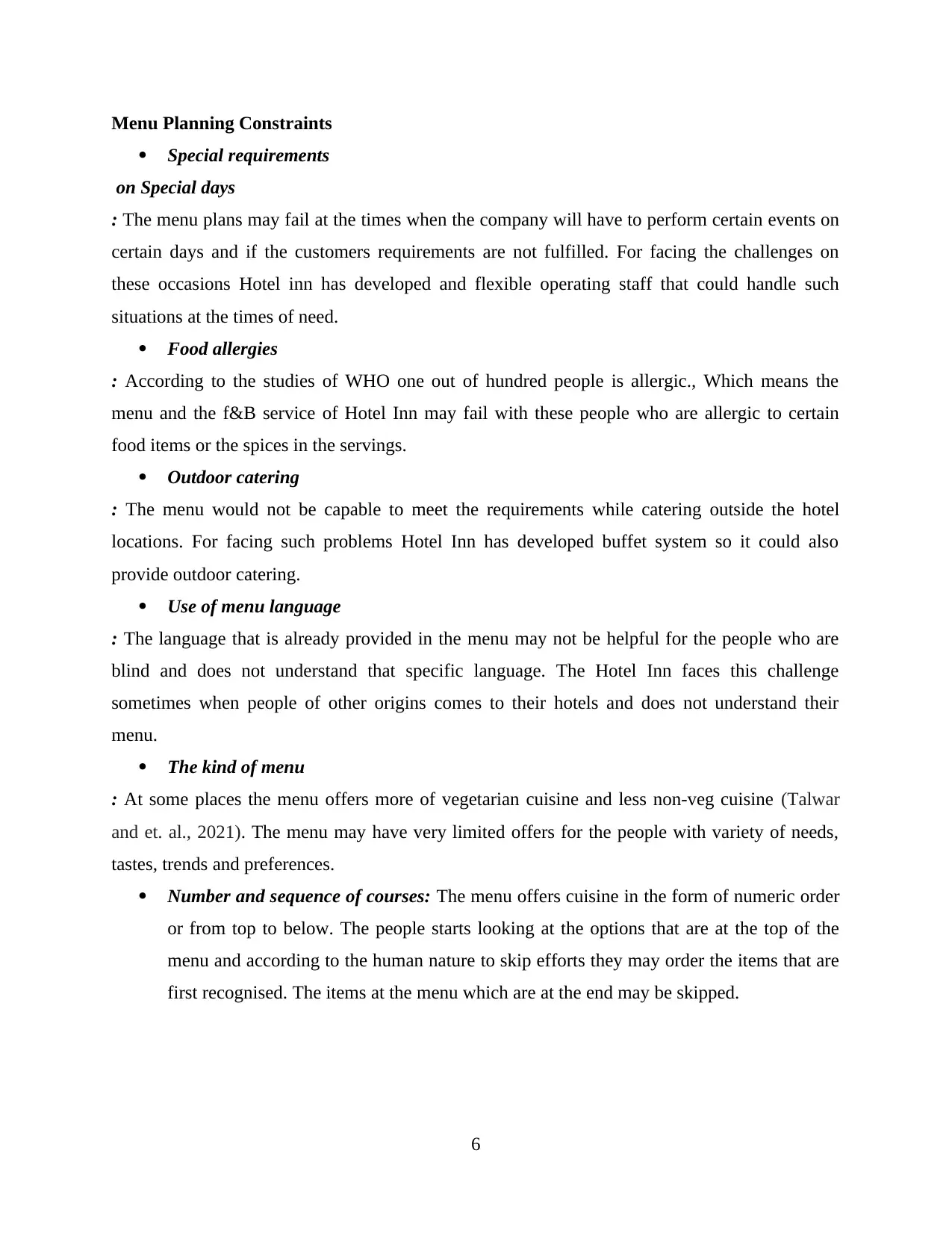
Menu Planning Constraints
Special requirements
on Special days
: The menu plans may fail at the times when the company will have to perform certain events on
certain days and if the customers requirements are not fulfilled. For facing the challenges on
these occasions Hotel inn has developed and flexible operating staff that could handle such
situations at the times of need.
Food allergies
: According to the studies of WHO one out of hundred people is allergic., Which means the
menu and the f&B service of Hotel Inn may fail with these people who are allergic to certain
food items or the spices in the servings.
Outdoor catering
: The menu would not be capable to meet the requirements while catering outside the hotel
locations. For facing such problems Hotel Inn has developed buffet system so it could also
provide outdoor catering.
Use of menu language
: The language that is already provided in the menu may not be helpful for the people who are
blind and does not understand that specific language. The Hotel Inn faces this challenge
sometimes when people of other origins comes to their hotels and does not understand their
menu.
The kind of menu
: At some places the menu offers more of vegetarian cuisine and less non-veg cuisine (Talwar
and et. al., 2021). The menu may have very limited offers for the people with variety of needs,
tastes, trends and preferences.
Number and sequence of courses: The menu offers cuisine in the form of numeric order
or from top to below. The people starts looking at the options that are at the top of the
menu and according to the human nature to skip efforts they may order the items that are
first recognised. The items at the menu which are at the end may be skipped.
6
Special requirements
on Special days
: The menu plans may fail at the times when the company will have to perform certain events on
certain days and if the customers requirements are not fulfilled. For facing the challenges on
these occasions Hotel inn has developed and flexible operating staff that could handle such
situations at the times of need.
Food allergies
: According to the studies of WHO one out of hundred people is allergic., Which means the
menu and the f&B service of Hotel Inn may fail with these people who are allergic to certain
food items or the spices in the servings.
Outdoor catering
: The menu would not be capable to meet the requirements while catering outside the hotel
locations. For facing such problems Hotel Inn has developed buffet system so it could also
provide outdoor catering.
Use of menu language
: The language that is already provided in the menu may not be helpful for the people who are
blind and does not understand that specific language. The Hotel Inn faces this challenge
sometimes when people of other origins comes to their hotels and does not understand their
menu.
The kind of menu
: At some places the menu offers more of vegetarian cuisine and less non-veg cuisine (Talwar
and et. al., 2021). The menu may have very limited offers for the people with variety of needs,
tastes, trends and preferences.
Number and sequence of courses: The menu offers cuisine in the form of numeric order
or from top to below. The people starts looking at the options that are at the top of the
menu and according to the human nature to skip efforts they may order the items that are
first recognised. The items at the menu which are at the end may be skipped.
6
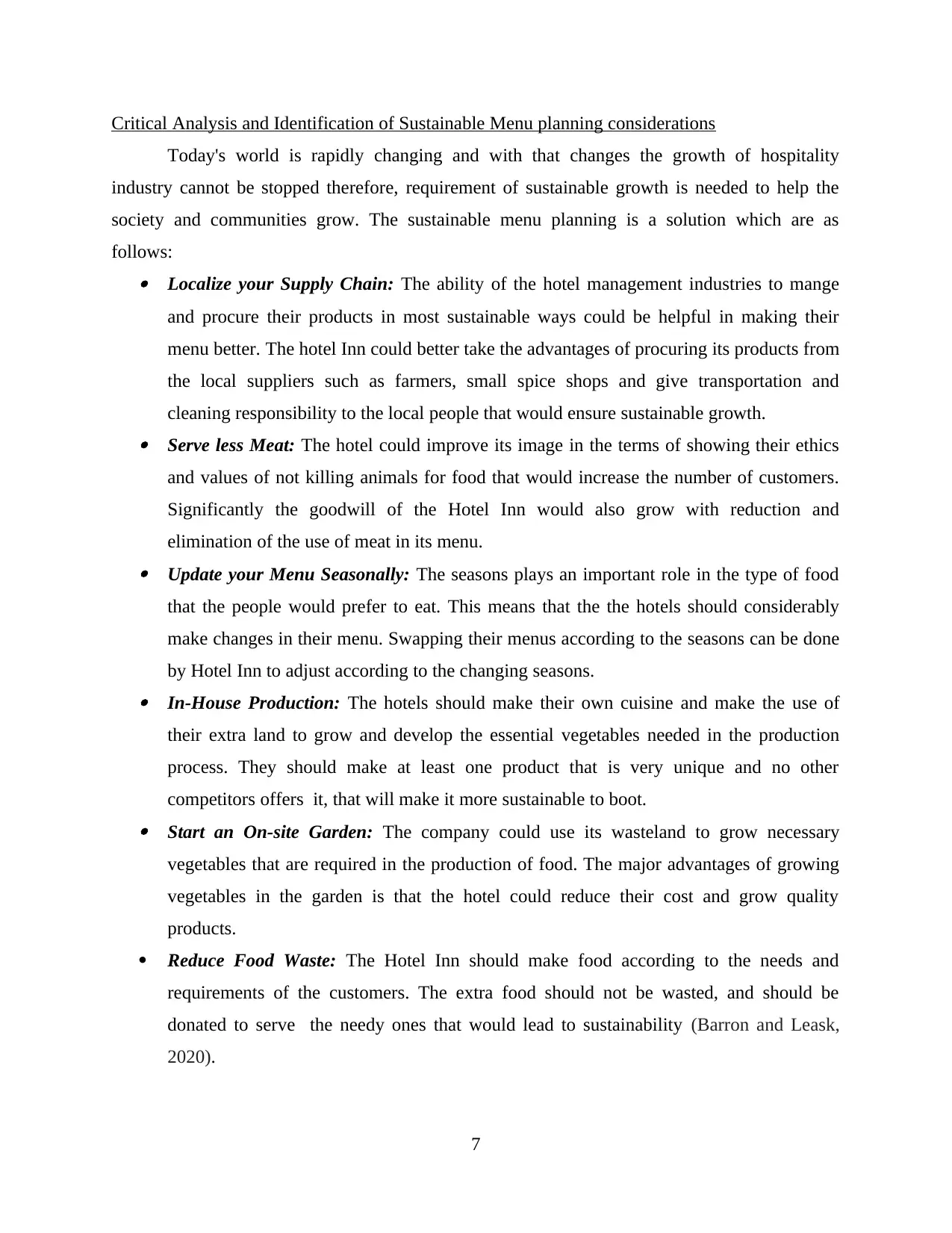
Critical Analysis and Identification of Sustainable Menu planning considerations
Today's world is rapidly changing and with that changes the growth of hospitality
industry cannot be stopped therefore, requirement of sustainable growth is needed to help the
society and communities grow. The sustainable menu planning is a solution which are as
follows: Localize your Supply Chain: The ability of the hotel management industries to mange
and procure their products in most sustainable ways could be helpful in making their
menu better. The hotel Inn could better take the advantages of procuring its products from
the local suppliers such as farmers, small spice shops and give transportation and
cleaning responsibility to the local people that would ensure sustainable growth. Serve less Meat: The hotel could improve its image in the terms of showing their ethics
and values of not killing animals for food that would increase the number of customers.
Significantly the goodwill of the Hotel Inn would also grow with reduction and
elimination of the use of meat in its menu. Update your Menu Seasonally: The seasons plays an important role in the type of food
that the people would prefer to eat. This means that the the hotels should considerably
make changes in their menu. Swapping their menus according to the seasons can be done
by Hotel Inn to adjust according to the changing seasons. In-House Production: The hotels should make their own cuisine and make the use of
their extra land to grow and develop the essential vegetables needed in the production
process. They should make at least one product that is very unique and no other
competitors offers it, that will make it more sustainable to boot. Start an On-site Garden: The company could use its wasteland to grow necessary
vegetables that are required in the production of food. The major advantages of growing
vegetables in the garden is that the hotel could reduce their cost and grow quality
products.
Reduce Food Waste: The Hotel Inn should make food according to the needs and
requirements of the customers. The extra food should not be wasted, and should be
donated to serve the needy ones that would lead to sustainability (Barron and Leask,
2020).
7
Today's world is rapidly changing and with that changes the growth of hospitality
industry cannot be stopped therefore, requirement of sustainable growth is needed to help the
society and communities grow. The sustainable menu planning is a solution which are as
follows: Localize your Supply Chain: The ability of the hotel management industries to mange
and procure their products in most sustainable ways could be helpful in making their
menu better. The hotel Inn could better take the advantages of procuring its products from
the local suppliers such as farmers, small spice shops and give transportation and
cleaning responsibility to the local people that would ensure sustainable growth. Serve less Meat: The hotel could improve its image in the terms of showing their ethics
and values of not killing animals for food that would increase the number of customers.
Significantly the goodwill of the Hotel Inn would also grow with reduction and
elimination of the use of meat in its menu. Update your Menu Seasonally: The seasons plays an important role in the type of food
that the people would prefer to eat. This means that the the hotels should considerably
make changes in their menu. Swapping their menus according to the seasons can be done
by Hotel Inn to adjust according to the changing seasons. In-House Production: The hotels should make their own cuisine and make the use of
their extra land to grow and develop the essential vegetables needed in the production
process. They should make at least one product that is very unique and no other
competitors offers it, that will make it more sustainable to boot. Start an On-site Garden: The company could use its wasteland to grow necessary
vegetables that are required in the production of food. The major advantages of growing
vegetables in the garden is that the hotel could reduce their cost and grow quality
products.
Reduce Food Waste: The Hotel Inn should make food according to the needs and
requirements of the customers. The extra food should not be wasted, and should be
donated to serve the needy ones that would lead to sustainability (Barron and Leask,
2020).
7
⊘ This is a preview!⊘
Do you want full access?
Subscribe today to unlock all pages.

Trusted by 1+ million students worldwide
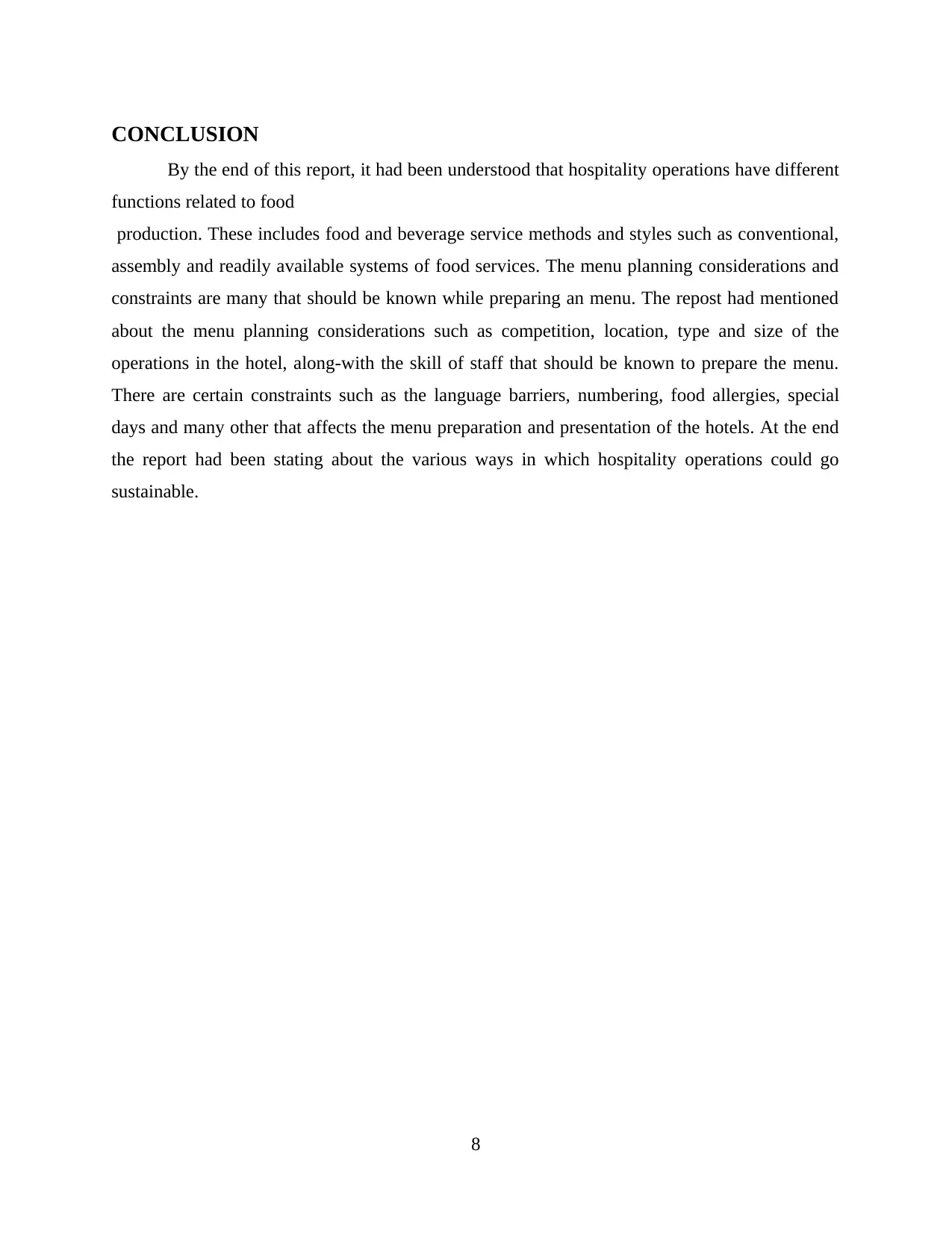
CONCLUSION
By the end of this report, it had been understood that hospitality operations have different
functions related to food
production. These includes food and beverage service methods and styles such as conventional,
assembly and readily available systems of food services. The menu planning considerations and
constraints are many that should be known while preparing an menu. The repost had mentioned
about the menu planning considerations such as competition, location, type and size of the
operations in the hotel, along-with the skill of staff that should be known to prepare the menu.
There are certain constraints such as the language barriers, numbering, food allergies, special
days and many other that affects the menu preparation and presentation of the hotels. At the end
the report had been stating about the various ways in which hospitality operations could go
sustainable.
8
By the end of this report, it had been understood that hospitality operations have different
functions related to food
production. These includes food and beverage service methods and styles such as conventional,
assembly and readily available systems of food services. The menu planning considerations and
constraints are many that should be known while preparing an menu. The repost had mentioned
about the menu planning considerations such as competition, location, type and size of the
operations in the hotel, along-with the skill of staff that should be known to prepare the menu.
There are certain constraints such as the language barriers, numbering, food allergies, special
days and many other that affects the menu preparation and presentation of the hotels. At the end
the report had been stating about the various ways in which hospitality operations could go
sustainable.
8
Paraphrase This Document
Need a fresh take? Get an instant paraphrase of this document with our AI Paraphraser
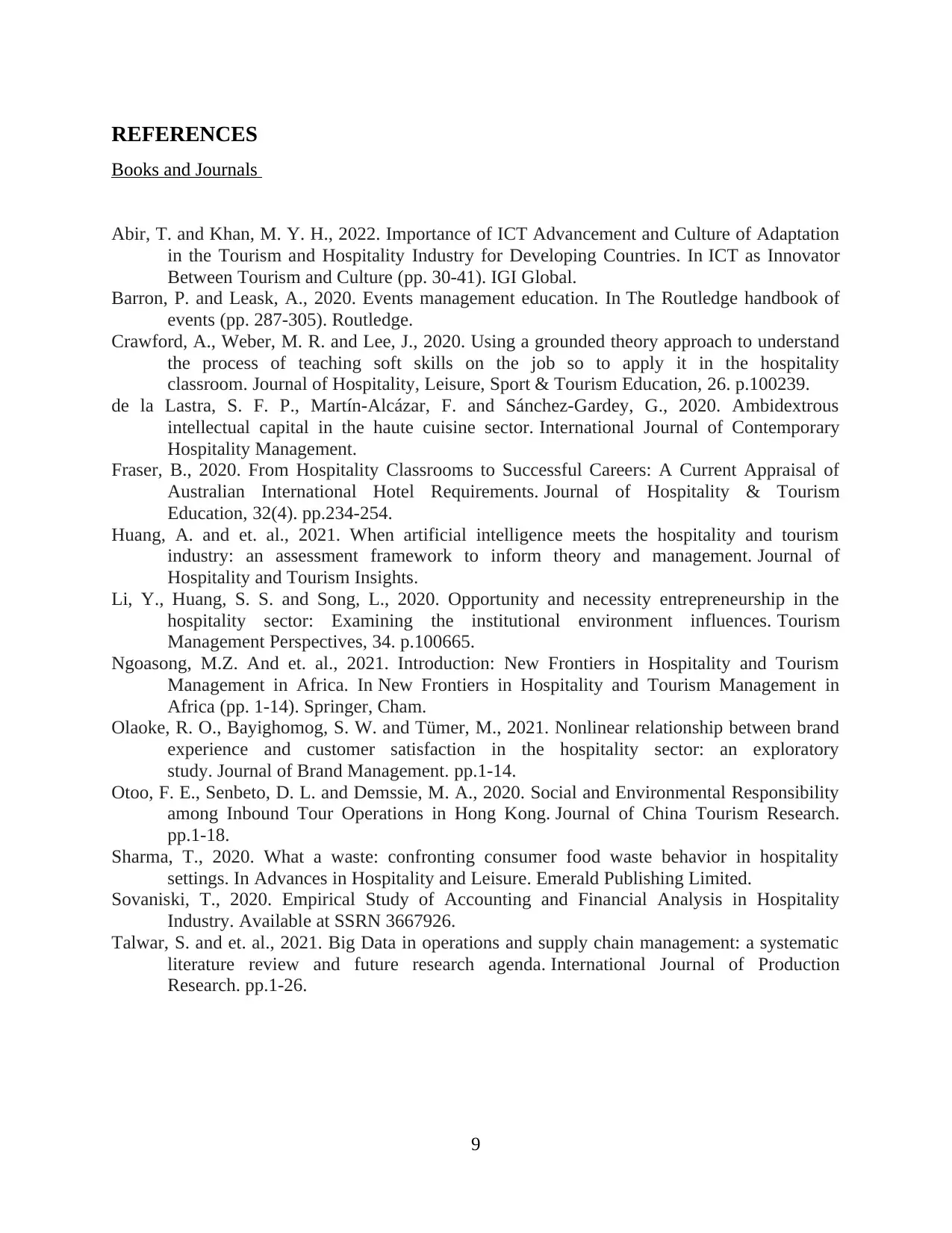
REFERENCES
Books and Journals
Abir, T. and Khan, M. Y. H., 2022. Importance of ICT Advancement and Culture of Adaptation
in the Tourism and Hospitality Industry for Developing Countries. In ICT as Innovator
Between Tourism and Culture (pp. 30-41). IGI Global.
Barron, P. and Leask, A., 2020. Events management education. In The Routledge handbook of
events (pp. 287-305). Routledge.
Crawford, A., Weber, M. R. and Lee, J., 2020. Using a grounded theory approach to understand
the process of teaching soft skills on the job so to apply it in the hospitality
classroom. Journal of Hospitality, Leisure, Sport & Tourism Education, 26. p.100239.
de la Lastra, S. F. P., Martín-Alcázar, F. and Sánchez-Gardey, G., 2020. Ambidextrous
intellectual capital in the haute cuisine sector. International Journal of Contemporary
Hospitality Management.
Fraser, B., 2020. From Hospitality Classrooms to Successful Careers: A Current Appraisal of
Australian International Hotel Requirements. Journal of Hospitality & Tourism
Education, 32(4). pp.234-254.
Huang, A. and et. al., 2021. When artificial intelligence meets the hospitality and tourism
industry: an assessment framework to inform theory and management. Journal of
Hospitality and Tourism Insights.
Li, Y., Huang, S. S. and Song, L., 2020. Opportunity and necessity entrepreneurship in the
hospitality sector: Examining the institutional environment influences. Tourism
Management Perspectives, 34. p.100665.
Ngoasong, M.Z. And et. al., 2021. Introduction: New Frontiers in Hospitality and Tourism
Management in Africa. In New Frontiers in Hospitality and Tourism Management in
Africa (pp. 1-14). Springer, Cham.
Olaoke, R. O., Bayighomog, S. W. and Tümer, M., 2021. Nonlinear relationship between brand
experience and customer satisfaction in the hospitality sector: an exploratory
study. Journal of Brand Management. pp.1-14.
Otoo, F. E., Senbeto, D. L. and Demssie, M. A., 2020. Social and Environmental Responsibility
among Inbound Tour Operations in Hong Kong. Journal of China Tourism Research.
pp.1-18.
Sharma, T., 2020. What a waste: confronting consumer food waste behavior in hospitality
settings. In Advances in Hospitality and Leisure. Emerald Publishing Limited.
Sovaniski, T., 2020. Empirical Study of Accounting and Financial Analysis in Hospitality
Industry. Available at SSRN 3667926.
Talwar, S. and et. al., 2021. Big Data in operations and supply chain management: a systematic
literature review and future research agenda. International Journal of Production
Research. pp.1-26.
9
Books and Journals
Abir, T. and Khan, M. Y. H., 2022. Importance of ICT Advancement and Culture of Adaptation
in the Tourism and Hospitality Industry for Developing Countries. In ICT as Innovator
Between Tourism and Culture (pp. 30-41). IGI Global.
Barron, P. and Leask, A., 2020. Events management education. In The Routledge handbook of
events (pp. 287-305). Routledge.
Crawford, A., Weber, M. R. and Lee, J., 2020. Using a grounded theory approach to understand
the process of teaching soft skills on the job so to apply it in the hospitality
classroom. Journal of Hospitality, Leisure, Sport & Tourism Education, 26. p.100239.
de la Lastra, S. F. P., Martín-Alcázar, F. and Sánchez-Gardey, G., 2020. Ambidextrous
intellectual capital in the haute cuisine sector. International Journal of Contemporary
Hospitality Management.
Fraser, B., 2020. From Hospitality Classrooms to Successful Careers: A Current Appraisal of
Australian International Hotel Requirements. Journal of Hospitality & Tourism
Education, 32(4). pp.234-254.
Huang, A. and et. al., 2021. When artificial intelligence meets the hospitality and tourism
industry: an assessment framework to inform theory and management. Journal of
Hospitality and Tourism Insights.
Li, Y., Huang, S. S. and Song, L., 2020. Opportunity and necessity entrepreneurship in the
hospitality sector: Examining the institutional environment influences. Tourism
Management Perspectives, 34. p.100665.
Ngoasong, M.Z. And et. al., 2021. Introduction: New Frontiers in Hospitality and Tourism
Management in Africa. In New Frontiers in Hospitality and Tourism Management in
Africa (pp. 1-14). Springer, Cham.
Olaoke, R. O., Bayighomog, S. W. and Tümer, M., 2021. Nonlinear relationship between brand
experience and customer satisfaction in the hospitality sector: an exploratory
study. Journal of Brand Management. pp.1-14.
Otoo, F. E., Senbeto, D. L. and Demssie, M. A., 2020. Social and Environmental Responsibility
among Inbound Tour Operations in Hong Kong. Journal of China Tourism Research.
pp.1-18.
Sharma, T., 2020. What a waste: confronting consumer food waste behavior in hospitality
settings. In Advances in Hospitality and Leisure. Emerald Publishing Limited.
Sovaniski, T., 2020. Empirical Study of Accounting and Financial Analysis in Hospitality
Industry. Available at SSRN 3667926.
Talwar, S. and et. al., 2021. Big Data in operations and supply chain management: a systematic
literature review and future research agenda. International Journal of Production
Research. pp.1-26.
9
1 out of 11
Related Documents
Your All-in-One AI-Powered Toolkit for Academic Success.
+13062052269
info@desklib.com
Available 24*7 on WhatsApp / Email
![[object Object]](/_next/static/media/star-bottom.7253800d.svg)
Unlock your academic potential
Copyright © 2020–2025 A2Z Services. All Rights Reserved. Developed and managed by ZUCOL.




